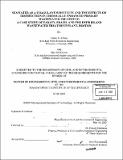| dc.contributor.advisor | Donald Harleman. | en_US |
| dc.contributor.author | Kfouri, Claire A., 1980- | en_US |
| dc.contributor.author | Kweon, Hyo Jin, 1978- | en_US |
| dc.contributor.other | Massachusetts Institute of Technology. Dept. of Civil and Environmental Engineering. | en_US |
| dc.coverage.spatial | s-bl--- n-us-ma | en_US |
| dc.date.accessioned | 2006-03-24T16:02:45Z | |
| dc.date.available | 2006-03-24T16:02:45Z | |
| dc.date.copyright | 2003 | en_US |
| dc.date.issued | 2003 | en_US |
| dc.identifier.uri | http://hdl.handle.net/1721.1/29565 | |
| dc.description | Thesis (M.Eng.)--Massachusetts Institute of Technology, Dept. of Civil and Environmental Engineering, 2003. | en_US |
| dc.description | Includes bibliographical references (leaves [133]-[135]). | en_US |
| dc.description.abstract | Paraty is a small touristic city on the South Eastern coast of Brazil plagued with public health problems inherently linked to its poor water and sanitation practices. This thesis centers on the design of an appropriate wastewater treatment facility for the City. The new and interesting use of seawater as a wastewater treatment tool and its effect on the disinfection potential of the treated effluent is also reviewed and tested in a series of jar tests and laboratory experiments Chemically Enhanced Primary Treatment (CEPT) is a wastewater treatment method that serves as an attractive alternative to conventional primary treatment and can also be used as an efficient preliminary step to biological secondary treatment processes. CEPT adopts coagulation and flocculation and accomplishes remarkable increases in the removals of common pollutants and contaminants from the influent. CEPT was chosen as the most favorable treatment alternative for Paraty as it is an expandable, economic and highly efficient system. The main advantage to CEPT is to generate an effluent that can be efficiently and economically disinfected at a low cost compared to secondary treatment. The most optimal dose of FeCl3, polymer and seawater to treat the Paraty sewage were estimated at 40mg/L, 0.1 mg/L and 5% seawater by volume respectively. Jar tests were also conducted at the Boston Deer Island WWTP to check the efficiency of using seawater as a coagulation enhancement mechanism on saline influents. CEPT effluents treated with FeCl3 were also tested for disinfection with both Paracetic acid (PAA) and Chlorine. Although PAA is an effective disinfectant, it was not included due to its high cost. The optimal chlorine dose for Paraty was estimated at 3 mg/L. Additional tests were conducted to test for the disinfectability of the Deer Island effluent treated with CEPT. These tests helped show that the sensitivity of disinfection in the presence of seawater is limited by low seawater concentrations. This thesis concludes with a detailed design of the treatment plant sedimentation tanks, chlorination/dechlorination chambers, and grit removal facility dimensions and draws general encouraging conclusions on the suggested use of seawater as a coagulation catalyst in chemically enhanced primary wastewater treatment. | en_US |
| dc.description.statementofresponsibility | by Claire A. Kfouri and Hyo Jin Kweon. | en_US |
| dc.format.extent | 132, [3] leaves | en_US |
| dc.format.extent | 14110532 bytes | |
| dc.format.extent | 14110339 bytes | |
| dc.format.mimetype | application/pdf | |
| dc.format.mimetype | application/pdf | |
| dc.language.iso | eng | en_US |
| dc.publisher | Massachusetts Institute of Technology | en_US |
| dc.rights | M.I.T. theses are protected by copyright. They may be viewed from this source for any purpose, but reproduction or distribution in any format is prohibited without written permission. See provided URL for inquiries about permission. | en_US |
| dc.rights.uri | http://dspace.mit.edu/handle/1721.1/7582 | |
| dc.subject | Civil and Environmental Engineering. | en_US |
| dc.title | Seawater as coagulant substitute and the effects on disinfection in chemically enhanced primary wastewater treatment : a case study of Paraty, Brazil and the Deer Island wastewater treatment plant, Boston | en_US |
| dc.type | Thesis | en_US |
| dc.description.degree | M.Eng. | en_US |
| dc.contributor.department | Massachusetts Institute of Technology. Department of Civil and Environmental Engineering | |
| dc.identifier.oclc | 52725053 | en_US |
